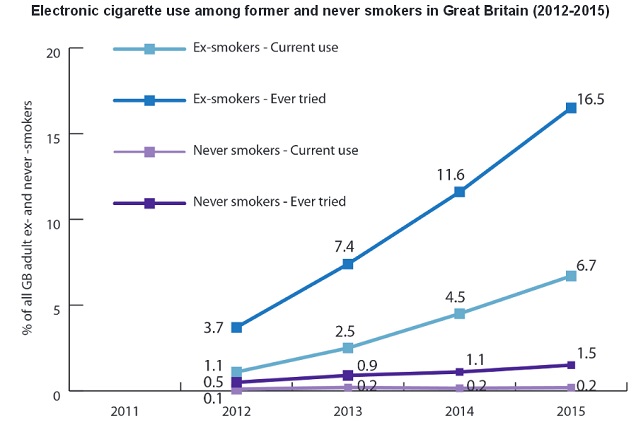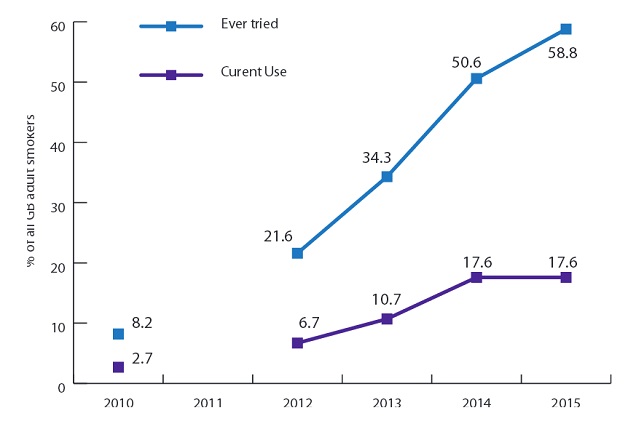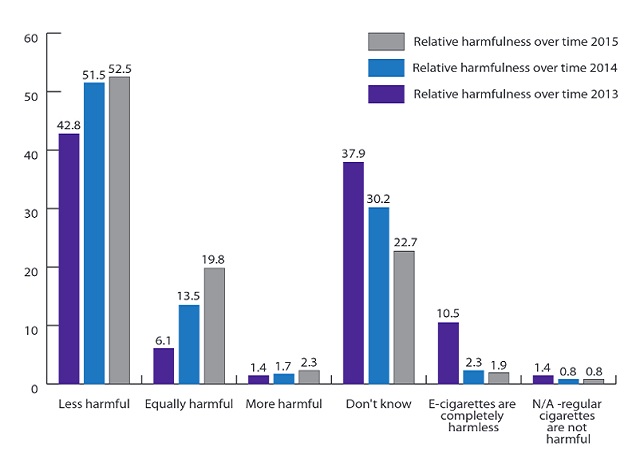
New data from ASH UK has shown that – much like in the US – the false belief that e-cigarettes are as dangerous as or more dangerous than smoking is becoming more common in both smokers and the general population. The new statistics also show that the proportion of ex-smokers who currently vape – likely due to having quit smoking with them – is increasing, but the previously rising rate of current use among smokers has stalled for the first time since ASH’s surveys begun in 2010. The implication is depressingly clear: frequent misleading statements about e-cigarettes are discouraging smokers from attempting to reduce the harm associated with their nicotine addiction.
The Results at a Glance
- ASH estimates that there are 2.6 million vapers in the UK, with 1.1 million ex-smokers (most of whom have quit through vaping) and 1.4 million current smokers among them.
- Use in never-smokers remains very low, with just 0.2 percent being current vapers in all surveys from 2013 to 2015.
- Current vaping among smokers rose from 2.7 percent in 2010 to 17.6 percent in 2014, but there has been no change from 2014 to 2015.
- The perception of risk from vaping is changing: in 2013, 43 percent of respondents correctly said vaping was safer than smoking, rising to 52.5 percent in 2015, and now only 2 percent incorrectly think that vaping is completely harmless. However, around 22 percent now incorrectly think that vaping is as bad or worse for you than smoking.
- Of smokers who’ve never tried vaping, 22 percent also say that vaping is no better for your health (or even worse than) smoking. Based on current estimates, that this means 900,000 smokers in the UK haven’t tried to switch and probably won’t because they’ve been misled on the risks of vaping.
The Survey – Looking at Trends in Vaping in Britain
The survey’s basic aim is to keep tabs on the trends in e-cigarette use in Britain, with previous surveys confirming, for instance, that use of e-cigs among never-smokers (adults or children) is extremely rare. This survey focused on adults, and adds to data collected each year since 2012 (as well as in 2010), offering a picture of the trends in vaping in the UK. The survey is conducted via YouGov, with the most recent data having been collected between February and March this year, covering a sample of over 12,000 adults.
How Many Vapers Are There, and How Many of Them Still Smoke?
As would be expected in 2015, almost all smokers and ex-smokers had heard of e-cigarettes (95 and 93 percent, respectively), and it’s estimated that there are 2.6 million adult vapers in the UK. Of those who currently vape, 1.1 million (42 percent) are ex-smokers (including those who quit smoking through vaping) and 1.4 million (54 percent) are current smokers too.
The overall increase in e-cig use – from 2.1 million last year to 2.6 million this year – is almost entirely due to the rising proportion of ex-smokers currently vaping, a sure sign that large numbers of smokers are successfully making the switch. Current use in never-smokers has been very low since 2012, starting at 0.1 percent, increasing to 0.2 percent in 2013 and having remained stable since then. More never smokers are trying vaping – up from 0.5 percent in 2012 to 1.5 percent in 2015 – but actual regular use is still every rare.

For current smokers – the most important group when it comes to vaping statistics – the previous increases in current use (from 2.7 percent in 2010 up to 17.6 percent in 2014) have now stopped, with no increase from 2014 to 2015. More smokers had tried an e-cigarette, reaching 58.8 percent in 2015 compared to 50.6 percent in 2014, but current use is no longer on the rise.

Perceptions of Risk from E-Cigarettes
The perceptions of harm from e-cigarettes show some disturbing trends from 2013 to 2015, particularly among smokers who haven’t tried vaping, although there are some positive signs too. For the sample as a whole, there has been an increase in the percentage correctly responding that e-cigarettes are less harmful than tobacco cigarettes, rising from 43 percent in 2013 to 52.5 percent in 2015. The number incorrectly responding that e-cigarettes are completely harmless has decreased from 10.5 percent in 2013 to 2 percent in 2015, and the percentage saying they don’t know has gone down from 38 to 23 percent.

Sadly, however, the percentage saying that e-cigarettes are just as harmful as cigarettes has increased from 6 to 20 percent. This undeniably reflects the impact of continuous misleading messages from the media and, occasionally, people who should know better. The numbers saying they’re “more harmful” have also increased, from 1.4 percent of respondents to 2.3 percent. This means that around 22 percent of respondents believe that e-cigs are either as harmful as or more harmful than combustible cigarettes (compared to just 7.5 percent in 2013), despite no study whatsoever indicating that this is even close to being true.
And now for the most depressing finding of all: of the smokers who’ve never tried vaping but know what e-cigs are, the number saying e-cigs are as harmful as or more harmful than smoking has increased from 12 to 22 percent over the last year. This is one to turn over in your mind a little: over one in five smokers who’ve never tried vaping (otherwise known as “people whose lives could potentially be saved by e-cigarettes”) have decided, despite no evidence at all suggesting this, that e-cigarettes are either just as bad as smoking or worse.
How Many Lives is Misinformation Going to Cost?
10 million adults in the UK smoke. Of these, about 58.8 percent have tried e-cigarettes, leaving 4.12 million smokers who’ve never tried vaping. According to the survey, about 900,000 of these are operating under the incorrect belief that e-cigarettes are just as bad (or worse) than cigarettes, and likely thinking to themselves, “well, I might as well keep smoking.”
And the smoking rate isn’t going down particularly quickly, going from 26 percent in 2002 to 20 percent in 2012. According to the latest data from Smoking in England, the smoking rate in England has been declining by about 0.7 percent each year from 2010 to 2015, roughly in line with the 2002 to 2012 figures for the whole of the UK. Now for the difficult questions: of the 900,000 smokers who’ve been misled about vaping and haven't tried it, how many will still be smoking in 10 years’ time? How many will still be smoking in 20 years’ time? How many will die because they’re never able to quit?
The answers don’t come easy, but it’s clear from the slow decline of the overall smoking rate that a substantial number will continue to smoke, until a fair proportion of them – up to half of the remaining smokers – will die prematurely. This is ultimately because the available options for quitting don’t work for everyone, and in fact, they don’t work for most smokers.
But what if these smokers weren’t horrendously misled about e-cigarettes? As many smokers have – including those who’ve tried and failed to quit using other methods – a substantial number of them would make the switch, or at least try to, and they could well stop smoking as a result. The crucial point is that e-cigarettes offer another option for smokers looking to quit, and it's one unlike anything else available. They’re an extra tool to help bring the smoking rate down, and discouraging vaping is effectively throwing this perfectly good tool out of the window for no valid reason whatsoever.
Anybody wanting to reduce the number of smokers – provided they have the tiniest remnant of common sense and some empathy for smokers who struggle to quit – would be encouraging all smokers to try vaping, because that would maximize the number of people who successfully quit. For some reason, though, many anti-smoking types have taken to doing the exact opposite, and the cost of this is measured in lost years of smokers’ lives.
Misleading People About Harm Reduction is Despicable
Dr. Leonie Brose of King's College London sums up the problem succinctly, “We must clearly communicate the relative safety of electronic cigarettes to smokers. The proven harm of tobacco is currently getting less coverage than the much smaller and far less certain harm from electronic cigarettes. We owe it to smokers to provide them with accurate information”
The upshot is: unless you really just want smokers to die, it’s probably better to stick to the science when you’re providing information about e-cigarettes. But that’s not what happens. Instead, hypothetical risks are blown out of all proportion and completely removed from the key comparison with combusted cigarettes. It’s entirely possible that this is simply done out of ignorance and stupidity, but the more of it you see, the less compelling that explanation seems.
We should all take a moment to recognize those who mislead smokers about reduced harm alternatives – smokeless tobacco and e-cigs alike – as what they are: despicable human beings. You may hate smoking, but that is no excuse for deceiving people about tobacco harm reduction, even if the alternative habit bears a passing resemblance. We can only hope that some of those 900,000 UK smokers realize they’ve been misled and decide to give vaping a try, and if they don’t – because we actually care about people – we sincerely hope they manage to quit smoking using any of the other available approaches, before it's too late.

